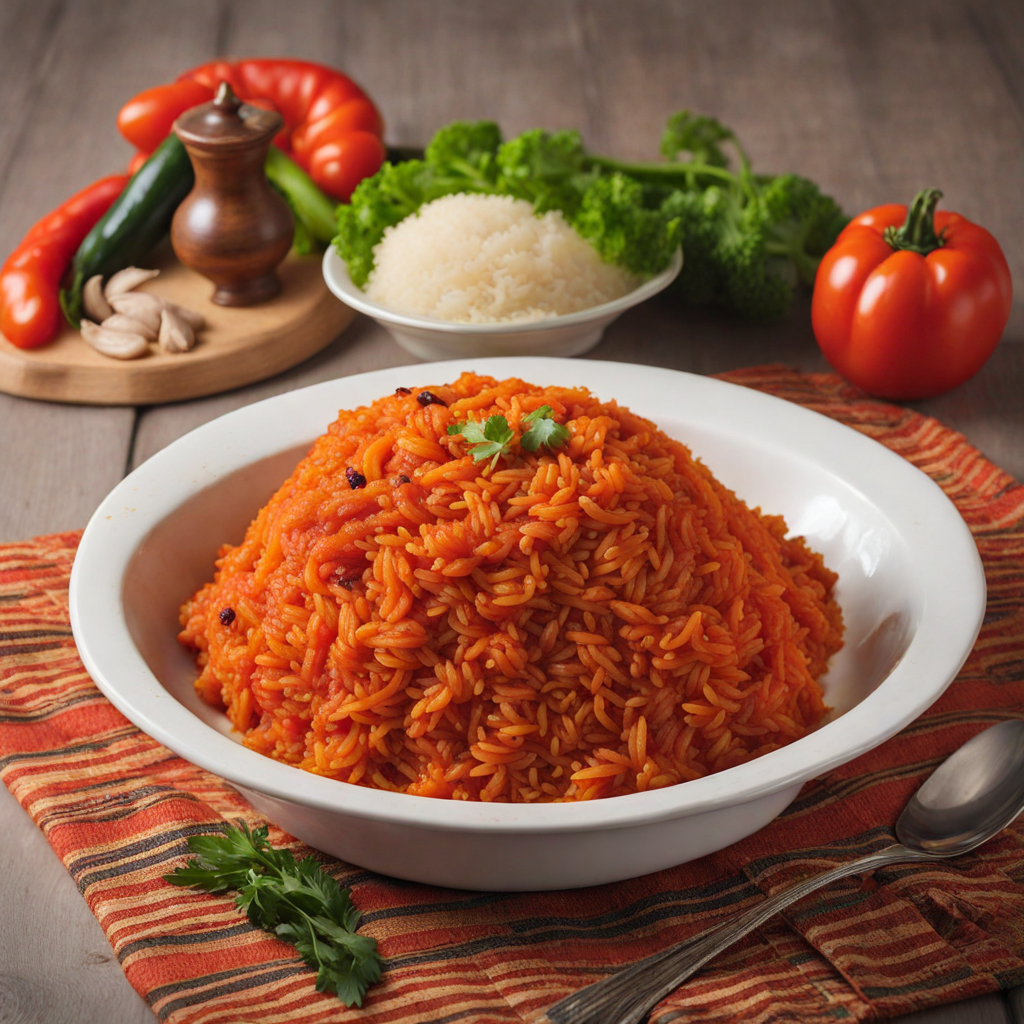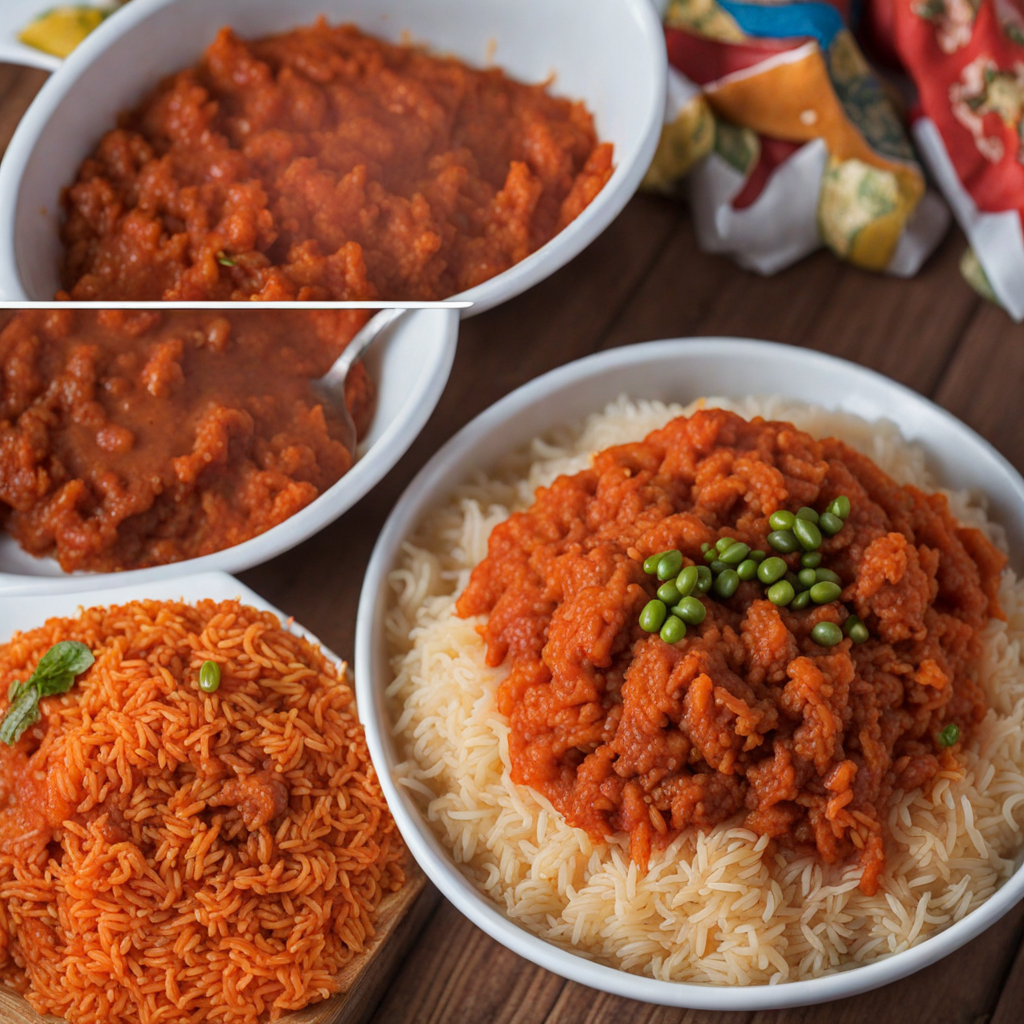Jollof Rice
Jollof Rice is a vibrant and flavorful dish that captures the essence of West African cuisine, particularly in Mali, where it is celebrated for its unique blend of spices and ingredients. The foundation of Jollof Rice lies in its perfectly cooked grains, which are infused with a rich tomato base that includes onions, garlic, and a variety of spices such as thyme, bay leaves, and a hint of chili pepper. This combination not only gives the rice its distinctive orange-red hue but also a depth of flavor that tantalizes the taste buds, making each bite an experience to savor. What sets Mali's Jollof Rice apart is the addition of local ingredients such as fresh vegetables, which bring a burst of color and nutrition to the dish. Peppers, carrots, and sometimes even peas are stirred into the rice, adding an extra layer of texture and sweetness. The rice is often cooked in a single pot, allowing all the flavors to meld beautifully, creating a comforting and hearty meal that can be enjoyed on its own or paired with grilled meats, fried plantains, or a spicy sauce for those who crave a bit more heat. Jollof Rice is not just a meal; it's a social experience often served during celebrations and gatherings, symbolizing unity and festivity. Each family may have its own twist on the recipe, making it a versatile dish that can be tailored to individual tastes. Whether you're a fan of bold spices or prefer a milder flavor, Jollof Rice offers a delightful journey into the heart of Malian culture, inviting you to explore the rich culinary traditions of West Africa.
How It Became This Dish
The History of Jollof: A Culinary Journey from Mali Jollof rice, a vibrant and flavorful dish, is a staple in West African cuisine and has transcended borders to become a beloved meal worldwide. Its roots can be traced back to the ancient civilizations of West Africa, particularly in Mali, where it began its journey as a symbol of community, cultural identity, and culinary innovation. #### Origins of Jollof The origins of Jollof rice are often debated, with several West African countries vying for its cultural ownership. However, historical evidence suggests that the dish can be traced back to the Wolof people of Senegal in the 14th century. The term "Jollof" itself is derived from the Wolof word "wolof," which refers to the people and their language. The dish originally consisted of rice cooked with tomatoes, onions, and spices, reflecting the agricultural practices and available ingredients of the region. Mali, a key player in the trans-Saharan trade during the medieval period, contributed significantly to the evolution of Jollof. The region was a melting pot of cultures, where traders and travelers exchanged not just goods but also culinary techniques and flavors. As rice became more widely cultivated and integrated into local diets, the preparation of Jollof began to vary, influenced by the diverse ethnic groups within Mali, such as the Bambara, Tuareg, and Songhai. #### Cultural Significance Jollof rice holds a prominent place in West African culture and is often associated with celebrations, gatherings, and communal feasts. It is more than just a dish; it is a symbol of unity and togetherness. In Mali, Jollof is traditionally served during weddings, festivals, and other significant events, bringing families and friends together around a shared meal. The dish has also become a canvas for cultural expression, with each community adding its unique twist to the recipe. Some may incorporate local ingredients such as smoked fish or meats, while others might use a variety of spices reflective of their culinary traditions. This adaptability has allowed Jollof to maintain its relevance and popularity across generations, making it a culinary emblem of West African identity. #### Development Over Time As Jollof rice spread throughout West Africa, it underwent various transformations, giving rise to regional variations. In Mali, the dish is often made with a base of tomato stew that includes bell peppers, onions, and spices, which are then mixed with parboiled rice. The use of palm oil adds richness and depth to the flavor, making it distinctively Malian. In neighboring countries, such as Nigeria and Ghana, Jollof has evolved into different forms, each claiming its recipe as the best. Nigerian Jollof, for instance, is known for its spicy kick, often incorporating scotch bonnet peppers, while Ghanian Jollof is characterized by a sweeter, smokier flavor, sometimes achieved through the use of charcoal during cooking. The ongoing "Jollof Wars" between these countries highlight the dish's significance in national identity and pride, each nation fervently defending its version as the quintessential Jollof. The globalization of Jollof rice cannot be overlooked. With the rise of the African diaspora, Jollof has made its way into kitchens around the world, from London to New York, where it is celebrated in restaurants and at events. The dish's adaptability has allowed it to resonate with people from different backgrounds, turning it into a symbol of cultural exchange and culinary diplomacy. #### Ingredients and Preparation At its core, Jollof rice is a dish that balances simplicity and complexity. The primary ingredients include rice, tomatoes, onions, and a variety of spices. The preparation typically begins with creating a base sauce, where tomatoes are blended with onions and sometimes peppers, then cooked down to create a thick stew. This sauce is seasoned with spices such as thyme, bay leaves, and sometimes ginger or garlic, adding layers of flavor. Once the sauce is ready, the rice is added and cooked in the tomato mixture, allowing it to absorb the vibrant flavors. The dish can be further enriched with proteins such as chicken, beef, or fish, and often served with fried plantains or a side salad to complement its richness. #### Modern Interpretations In contemporary times, Jollof rice has inspired countless culinary innovations, with chefs experimenting with fusion recipes and modern cooking techniques. Vegan and vegetarian versions have emerged, catering to dietary preferences while maintaining the dish's essential character. Additionally, the rise of social media has given Jollof a new platform, with food enthusiasts sharing their recipes, cooking tips, and personal stories, further elevating its status in popular culture. Jollof has also made its mark in international culinary competitions, showcasing the dish's versatility and global appeal. The annual Jollof Festival, held in various cities, celebrates the dish with cooking contests, tastings, and cultural performances, bringing together individuals from diverse backgrounds to honor this West African culinary treasure. #### Conclusion Jollof rice is more than just a dish; it is a celebration of heritage, a testament to the rich tapestry of West African culture, and a symbol of community and togetherness. From its origins in Mali to its widespread popularity today, Jollof has evolved and adapted, reflecting the dynamism of the cultures it represents. As it continues to capture hearts and palates around the world, Jollof rice stands as a delicious reminder of the power of food to unite people, transcend borders, and tell stories that span generations. Whether enjoyed at a family gathering or in a trendy restaurant, Jollof remains a cherished dish that embodies the spirit of West Africa—a true culinary masterpiece worthy of its place on the global stage.
You may like
Discover local flavors from Mali







